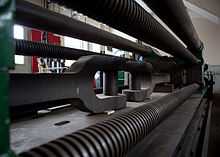Kirkaldy Testing Museum
| Kirkaldy Testing Museum | |
|---|---|
 | |
| Established | 1983 |
| Location | 99 Southwark Street, Southwark, London, England |
| Public transit access | Southwark |
| Website | Kirkaldy Testing Museum |

The Kirkaldy Testing Museum is a museum in Southwark, south London, England, in David Kirkaldy's former testing works. It houses Kirkaldy's huge testing machine, and many smaller more modern machines.[1] It is open on the first Sunday of each month.
David Kirkaldy and his Universal Testing Machine
Kirkaldy worked at Napier shipbuilding works, where he was Chief Draughtsman and Calculator.[2] He left in 1861 and over the next two and a half years studied existing mechanical testing methods and designed his own testing machine. William Fairbairn had pioneered tensile strength measurement as well as assessing creep and fatigue on large structures as well as small. Entirely at his own expense, Kirkaldy commissioned this machine from the Leeds firm of Greenwood and Batley, closely supervising its production. Aggrieved over the slow rate of manufacture, after 15 months he had it delivered to Southwark still unfinished, in September 1865.
Kirkaldy's original works was on The Grove, Southwark SE1.[2] in 1874 he moved it to purpose-built new premises at 99 Southwark Street.[2]
The testing machine is 47 feet 7 inches (14.50 m) long and weighs some 116 tons. It works horizontally, the load applied by a hydraulic cylinder and ram. The working fluid is water not oil. The load is measured by a weighing system consisting of a number of levers with the final one carrying a jockey weight. The operator lets water into the hydraulic cylinder and as the pressure and hence load on the test piece increases the jockey weight is wound along to balance the hydraulic load. As it is wound it moves along a graduated scale and when the object under test fails the number on this scale is noted and multiplied by the weight to give the failure load. The weight can be varied in increments of 50 pounds (23 kg) using slotted plates on a hanger. On the lower scale this reads up to 150 pounds (68 kg), and up to 1,000 pounds (450 kg) can be put onto the hanger. A separate jockey weight system above this one allowed the machine to measure loads of up to 1,000,000 pounds (450 t).[1]
The machine is kept in working order at the Kirkaldy Museum in Southwark. Problems can occur with the gasket which seals the single hydraulic cylinder. The gasket is in the original material, leather, rather than a more modern material. Originally the London Hydraulic Power Company supplied the high-pressure water, but now the museum uses an electric pump. When breaking specimens for visitor demonstrations a load not exceeding 20 tons is used.
Kirkaldy also developed methods for examining the microstructure of metals using optical microscopy. It involved cutting sections, polishing the sections and then etching to reveal different constituents.

Notable tests
The Kirkaldy works tested components for the Eads Bridge across the Mississippi River in St. Louis, USA, which was completed in 1874, and for the Skylon that was built for the nearby Festival of Britain in 1951.[2] It also helped accident analysis by tested materials from structures that failed, including the Tay Bridge Disaster of 1879 and the BOAC Flight 781 De Havilland Comet crash of 1954.[2]
Tay bridge disaster
In 1880[2] Kirkaldy tested many samples from the first Tay railway bridge for the official Inquiry into the collapse of the bridge's central section on 28 December 1879. He confirmed that the wrought iron tie bars failed at their connections to the cast iron columns of the bridge, when he tested intact tie bars with complete lugs still attached. The attachments were cast iron lugs which fractured at the bolt holes, and numerous fractured lugs were found after the disaster lying on the piers. The critical strengthening elements were much weaker than had been supposed by Thomas Bouch, the engineer of the first bridge. They failed at about 20 tons tensile load rather than the specified 60 tons, and were a prime cause of the collapse of the bridge.
Since Kirkaldy tested several samples of each of the lower and upper lugs, he was able to show that they exhibited a range of strengths, the lowest results being caused by defects like blow holes in the cast metal. Thus some of the upper lugs were actually weaker than the strongest lower lugs, an observation confirmed by damage shown on the remains left on the piers after the disaster. He tested the wrought iron tie bars themselves, and they proved tough, as specified, although only slightly stronger than the cast iron lugs to which they were attached. The high girders were also made of wrought iron and had a very high tensile strength. They were found after the accident at the bottom of the Tay estuary and had sustained relatively little damage compared with the cast iron columns which supported them. Some were reused in local houses, and when they were demolished in the 1960s, some were removed to the Royal Museum of Scotland in Edinburgh, where they are on public display.
References
External links
- Kirkaldy museum website
- Kirkaldy museum location
- ?, Ian (10 April 2008). "The Kirkaldy Testing Museum". Ian Visits.
- Choudhury, Paul (6 January 2011). ""Facts not Opinions": A visit to the Kirkaldy Museum". Sumitsays.
Coordinates: 51°30′21.47″N 0°6′5.58″W / 51.5059639°N 0.1015500°W